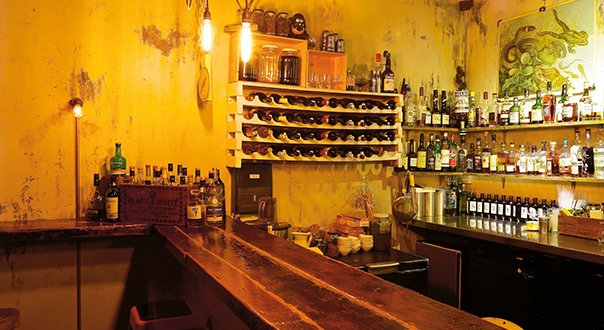As told to Sam Bygrave
Sydney’s Bulletin Place is up there on the World’s 50 Best Bars list, won Cocktail Bar of the Year at last year’s Bar Awards, and this year is nominated in no less than six categories, including for Cocktail List of the Year.
The key thing you need to know about this bar is that the menu changes daily, depending on what they get from the markets that morning.
We asked co-owner Adi Ruiz to tell us about the philosophy that guides their drinks and doing the seasons right. Here’s what he told us:
My philosophy kind of comes from David Chang, and I’ve read a couple of his books. His point was if you find a primary producer who puts all of their effort and all of their into producing the best primary ingredient they can, if you turn around and take that ingredient and don’t treat it well or you fuck it up, that makes you an asshole.
The mission was how are we going to find the best produce available? That lead us to Matt Brown, who’s our go-to guy — we’re on the phone to him every day, having conversations about the produce. We want to find the single best piece of produce, in the heart of the season, that we can.
He’s like a pusher. He’s a celebrity produce pusher in the city. He is expensive, not all restaurants use him, but a lot of the better ones do. He’s just got his finger on the pulse, he’s got the time to develop and nurture relationships with growers all over New South Wales. I’d love that to be me, but at the same time I’ve got to run a bar — I don’t have time to be in Western Sydney at five o’clock in the morning. So he’s our eyeballs on every piece of produce.
It’s a little bit of a tricky place to be. But that philosophy is always there, and we’re always chasing the very best produce no matter what.
I liken our drinks a little bit to Italian food: they take really good ingredients and they do something simple with it. Rather than French cooking which is layer upon layer and lots of development.
Our driving force is this: we’ve got this produce and it’s so good and so simple, how do we elevate this, elevate the spirit in the drink? And simple drinks are always the very best ones that we do. The very best ones have always been the simplest.
Our hero drink would be the Black Cherry Bramble. It was one of the first ones we ever did, right at the end of December at the start of the cherry season. It was just three or four black pitted cherries, splatted into the bottom of the glass, one and a half ounces of gin, lemon, touch of sugar, dash of pastis. That’s it. Just crush the cherries in the bottom of the glass, churn it up a bit so you release the colour of the juice and then just build on top so you have that nice graduated layer to it.
You’ve got to couple that with the cubed ice machine, frozen-as-shit glassware — that stuff is paramount.
Technique as well: overshake, understir, too little ice in the shaker, or if you’ve been a bit busy and the freezer’s [temperature] is not where it should be — there’s a lot of things that can slip and bring it from a 95 per cent drink to an 85 per cent drink.
The first thing to do is to know the seasonality. Know what’s good and when. That information is free and available online. There’s a growing phase south to north in Australia. So Victoria kicks off first, then it goes to New South Wales and then Queensland, so there’s three phases for every produce as the weather heats up or cools down.
British strawberries in season — I’ve never tasted anything like it. They need a cooler climate. So it’s the end of June and there’s Queensland strawberries available now, but there just a bit flabby and obvious. They just don’t carry — you want something that pops. Strawberries are an absolute nightmare.
Flavour: as sugar develops, acid drops (generally) across key produce. Pineapple is a really good example.It’s a bitch to get really, really good pineapple. When you get a good one you can tell by the colour, it needs to have some yellow on it, it needs to smell sweet. They don’t sit very well – they need to ripen in the field, because the ones that are ripening in the supermarket, they just don’t quite get there.
Passionfruit, strangely, is a really hit and miss one. There’s so many varieties of passionfruit, and even at the grower level it is really hard to pick passionfruit that you want. A lot of the time it can be powdery, lots of acid but very little impact of flavour. You want a balance of acid and flavour. And there’s so little yield to them. Sometimes you open them and you get one drink out of two passionfruits!
American produce? Nah. We just can’t do it. People probably wouldn’t be able to tell, if you shook American cherries into a drink with a few other ingredients, you can make a decent drink. But they’ve just got completely different food standards from us. Their oranges are so fucking scary. We get a lot of American oranges, particularly out of our season, and they’re actually sprayed with colour — it’s a pretty hectic carcinogen.
There was a phase there in the early 2000s where every fruit was bolstered by its corresponding liqueur: strawberries with fraise, raspberries with crème de framboise. Everyone’s hands are dirty on that (mine are too).
Anything that clouds the message is bad. Anything even vaguely parallel, I’ve found, doesn’t support the message. So say, Cherry Heering with berries, it’s a little bit too similar-similar. So if we do use any liqueurs, we really want to create contrast with it. Curacao and passionfruit, pineapple and Chartreuse — things that definitely don’t swim together on paper but when in the glass they really contrast.
If the produce is not perfect, you just can’t use it or you’ll compromise what you do. It sucks when you get this produce in and you taste it and you think: shit, it’s two days away from being ripe and I need this today. Plan B: put on a stirred drink!



